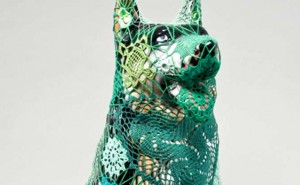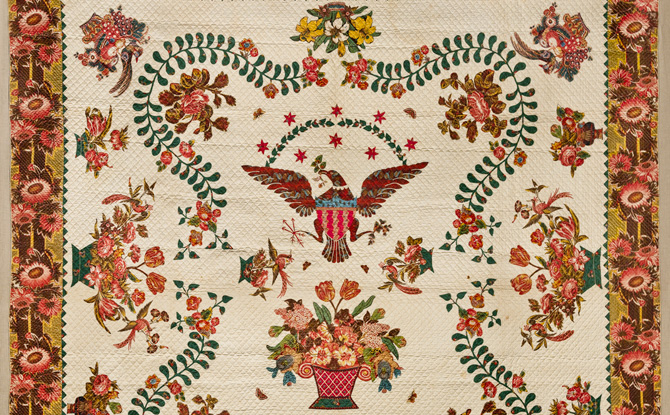Why Quilts Matter – Question & Answer with Virginia Treanor
During our ongoing Q&A series we have spoken with quilt artists, collectors, fabric designers and textile historians. But what about the many museums with quilt collections? Why do so many museums recognize the importance of quilts and include them in their textile collections? How are they significant to a museum’s mission and why does the acquisition and exhibition of these quilts matter to them?
Located in the heart of Washington, D.C., the National Museum of Women in the Arts (NMWA) is the only museum in the world dedicated exclusively to recognizing the achievements of women artists. The museum is currently featuring an innovative display, Workt by Hand, showcasing 35 18th–20th-century quilts from the Brooklyn Museum’s renowned decorative arts collection. “Revealing the shifting cultural status of this medium, the exhibition explores issues specific to quilting practices, such as anonymity versus authorship and the conventional view of quilts as craft rather than fine art.”

Installation view of ‘Workt by Hand: Hidden Labor and Historical Quilts’ at the National Museum of Women in the Arts. Photography by Lee Stalsworth.
Kentucky Quilt Project founder Shelly Zegart recently collaborated with NMWA Associate Curator Virginia Treanor on an exclusive, 30-minute compilation video of Why Quilts Matter: History, Art & Politics to feature in this exhibit. The featured short film, on continuous view in the exhibit gallery, explores a wide range of topics including how quilts are viewed in the art world, how they’ve empowered women over the years, how they are studied and more.
We spoke with Virginia about how a museum professional perceives how quilts have factored in to history and political activism.
Historically, quilts were often the voice of political and socially conscious women. Contemporary quilt makers often carry on that tradition of needle activism. Does fiber art in your museum’s collection reflect political or social issues? How could you use a quilt exhibition to direct attention to women’s issues and causes?

Miriam Schapiro, Mechano/Flower Fan, 1979; Gift of Mary Ross Taylor in honor of her mother, Betty S. Collection of the NMWA
I think any fiber art made by a woman artist engages ideas about the traditional association of women and textiles. Whether or not that is something that the artist is consciously thinking about during an object’s creation, I can’t say but given the fact that across the globe most needlework has historically been done by women you can’t really escape the connection between that history and a work of art that incorporates fiber/textile/needlework.
In NMWA’s collection we certainly have pieces where this connection can be seen. Miriam Schapiro, one of the grand dames of the Feminist Art Movement, purposefully utilized fiber materials in her work to pay homage to earlier women (like quilters) whose work so often went unrecognized as art. The Earth (1984) by Kimsooja is a work made from cloth that references the form of the kimono, a traditional costume from the artist’s native Korea. Kimsooja has noted that her work with textiles is directly inspired by memories she has of working with her mother, sewing bedclothes.

Joana Vasconcelos, Viriato, 2005; Heather and Tony Podesta Collection, Washington, D.C.; © Luis Vasconcelos/ courtesy Atelier Joana Vasconcelos . Collection of the NMWA
Even today, women artists are still exploring the multivalent associations that textiles evoke. Portuguese artist Joana Vasconcelos is known for ensconcing objects – from boats to pianos to laptops – in crocheted and knitted material. In doing so, she juxtaposes the commercially, machine-made objects with something hand-made, and primarily associated with the domestic. These often jarring pairings raise questions of public vs. private spheres of art, mass production with skilled labor and the gendering of these areas.
I can answer the second part of the question without speculating because NMWA is doing just that with our current exhibition, “Workt by Hand”: Hidden Labor and Historical Quilts”. This exhibition, organized by the Elizabeth A. Sackler Center for Feminist Art at the Brooklyn Museum, is wonderful not only because of the gorgeous historical quilts on display but also because it provides historical context for how these objects have been perceived in our society over the past 150 years. Quilts, like so many other ‘decorative arts,’ have not traditionally been viewed as art because their makers are overwhelmingly women.
Quilts have been largely categorized by museums as “decorative arts.” How has that designation made it harder for the medium to be taken seriously?

Elizabeth Welsh of Virginia, Medallion Quilt, ca. 1830; Brooklyn Museum, Gift of the Roebling Society; Photo Gavin Ashworth 2012, courtesy of the Brooklyn Museum.
The designation of quilts as ‘decorative art’ has undoubtedly made it harder for them to be given the same consideration as paintings or sculpture. First of all, I find the term ‘decorative art’ to be a little misleading. To label objects that have their origins in utility ‘decorative,’ doesn’t make a whole lot of sense to me. Meanwhile, I think it could be argued that other ‘high’ art forms like painting and sculpture are, in many ways, more purely decorative than objects like textiles and pottery. But, that’s just my two cents!
It’s been almost a century since Marcel Duchamp signed a urinal, hung it on the wall and called it art and yet the dialogue about what defines ART is still going on. Unfortunately, these divisions between ‘high’ and ‘low’ art remain in most museums and as long as quilts (or pottery, weaving or any other ‘craft’) continues to be designated as ‘decorative,’ it’s going to be an uphill battle in terms of garnering the same status as a work of ‘fine’ art.
What’s next for you?
A small exhibition on the work of Judy Chicago, Judy Chicago: Circa ’75 opened in January and will run through April 13, 2014. Chicago is celebrating her 75th birthday in 2014 so we thought it fitting to honor her legacy with a show of selected works from the 1970s. She often uses media that have long been associated with women, like textiles and porcelain. As for our larger exhibition space (where Workt by Hand is now) we have something very different up our sleeves! Total Art: Contemporary Video will explore the role of women artists in the development of video art. They have been at the forefront of the medium from its inception and thus have had an equal hand in shaping the field.
More
For more information and exhibition schedules, visit the website of the National Museum of Women in the Arts.
Photo credits:
Installation view of Workt by Hand: Hidden Labor and Historical Quilts at the National Museum of Women in the Arts. Photography by Lee Stalsworth.
Miriam Schapiro, Mechano/Flower Fan, 1979; Gift of Mary Ross Taylor in honor of her mother, Betty S. Collection of the NMWA.
Joana Vasconcelos, Viriato, 2005; Heather and Tony Podesta Collection, Washington, D.C.; © Luis Vasconcelos/ courtesy Atelier Joana Vasconcelos . Collection of the NMWA.
Elizabeth Welsh of Virginia, Medallion Quilt, ca. 1830; Brooklyn Museum, Gift of the Roebling Society; Photo Gavin Ashworth 2012, courtesy of the Brooklyn Museum.


